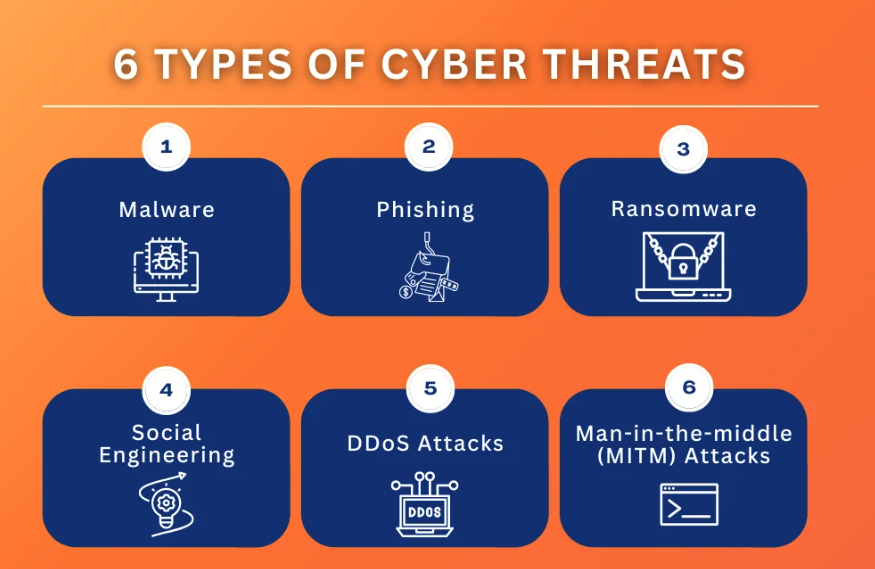Understanding the types of cyber attacks is not just a matter of technical curiosity; it’s about safeguarding our digital lives.
With the digital landscape evolving rapidly, the sophistication and frequency of cyber threats have escalated.
A recent report from CrowdStrike 2023 Global Threat Report highlights this with a 95% increase in cloud exploitation and a notable rise in access broker activities on the dark web by 112% from the previous year.
This indicates an increase in the number of attacks but a significant evolution in their complexity and the methods employed by adversaries.
Similarly, the IBM Security X-Force Threat Intelligence Index 2023, highlighted by Michael Worlay in the Security Intelligence Podcast, reveals a shift in the cyber threat landscape, with phishing and vulnerability exploitation remaining the top initial access vectors.
This shift underscores the adaptability of threat actors in exploiting human factors and system vulnerabilities to gain unauthorized access.
Yes, attacks have become more refined, targeting not just random individuals but strategic sectors like healthcare, finance, and government institutions.
This pressing situation underscores the importance of understanding the different types of cyber threats for IT professionals and everyone.
Therefore, based on the Cisco cyber attack guideline, this article will focus on 10 types of cyber attacks.
Malware Attacks
Malware attacks, including viruses, worms, and trojans, continue to pose significant threats in 2024.
Viruses attach to files, worms self-replicate across networks, and trojans disguise themselves as benign software.
The Malwarebytes State of Ransomware Report highlights the severity, with 1,900 ransomware attacks in the US, Germany, France, and the UK.
Rapid exploitation of vulnerabilities is also a concern, as Qualys Threat Research Unit noted, with 25% of high-risk vulnerabilities exploited on the day of publication.
For small businesses, key cybersecurity tips include educating employees on email safety, updating software, and using reliable security tools.
Understanding and addressing these diverse malware threats is crucial for adequate protection.
Phishing Attacks
Phishing attacks are a prevalent and evolving threat in the cyber landscape, where attackers use deceptive emails, websites, or communication channels to trick users into revealing sensitive information.
The concept of phishing involves social engineering tactics to manipulate users into actions such as clicking malicious links, downloading harmful files, or divulging personal details.
Attackers are constantly finding new ways to bypass security defenses, employing sophisticated techniques that are increasingly effective.
With a total of 1,279,086,245 phishing attacks observed, Zscaler’s 2023 Phishing Report reveals a staggering 47.2% increase in phishing attacks compared to the previous year.
Education was the most targeted industry, with a 576% increase in attacks, while Retail and Wholesale saw a 67% decrease from 2021.
This growth is attributed to the use of phishing kits and AI tools such as ChatGPT, which make it easier for attackers to develop targeted campaigns that bypass traditional security models, including multi-factor authentication (MFA).
As phishing techniques become more sophisticated, it is crucial for both individuals and organizations to understand and recognize these tactics to prevent costly data breaches and protect sensitive information.
Ransomware Attacks
In these attacks, perpetrators encrypt a victim’s data and demand payment for its release, often threatening to leak or destroy the data if their demands are not met.
The consequences of falling victim to a ransomware attack can be severe, including operational disruption, financial loss, data breach, reputational damage, and, in some cases, legal implications.
In 2023, ransomware attacks reached an all-time high, with a report from Malwarebytes showing 1,900 attacks in just four countries (the US, Germany, France, and the UK).
The US experienced a substantial 43% of these global attacks, with ransomware groups increasingly employing sophisticated techniques like exploiting zero-day vulnerabilities.
Sophos, in The State of Ransomware 2023, also shed light on the financial losses from ransomware attacks, noting that the average ransom in 2023 was $1.54 million, almost double the $812,380 in 2022.
For instance, the Clop ransomware group’s attack on MOVEit Transfer, impacting millions of individuals, and an attack on the City of Oakland, California, led to a declaration of a local state of emergency.
Consequently, organizations and individuals need to implement robust cybersecurity measures, perform regular data backups, and stay abreast of the latest ransomware trends.
The ultimate goal is to mitigate the risks associated with these increasingly sophisticated attacks.
Distributed Denial of Service (DDoS) Attacks
Distributed Denial of Service (DDoS) attacks have become a prevalent threat in the cyber landscape, characterized by overwhelming a system or website with excessive traffic.
These attacks aim to disrupt services and can cause significant financial loss.
DDoS attacks are executed by flooding a target with a massive volume of requests, rendering the system incapable of responding to legitimate traffic.
Recent trends show that DDoS attacks continue to pose a severe threat.
For example, Cloudflare’s DDoS threat report for Q1 2023 revealed that China experienced the highest amount of network-layer DDoS attack traffic, accounting for nearly 18% of all such traffic worldwide.
F5 Labs’ 2023 DDoS Attack Trends report indicated a notable increase in application vector attacks, which grew by 165% in 2022.
This shift suggests that attackers are adapting their strategies to be more effective, particularly as traditional DDoS methods become more complicated to execute against increasingly robust defenses.
These trends emphasize the evolving nature of DDoS attacks and the need for organizations to implement robust cybersecurity measures, including DDoS protection tools, to mitigate the impact of these attacks.
Man-in-the-Middle (MitM) Attacks
Man-in-the-Middle (MitM) attacks are a type of cyber attack where hackers intercept and manipulate communication between two parties, often without their knowledge.
In these attacks, the hacker positions themselves in the communication channel and can capture, modify, or fabricate the exchanged data.
This interception can lead to the theft of sensitive information such as login credentials, personal data, financial information, and corporate secrets.
A survey by Enterprise Management Associates via BusinessWire found that nearly 80% of TLS certificates on the internet are vulnerable to MitM attacks, and up to 25% of all certificates are expired at any given time, making them susceptible to such attacks.
MitM attacks emphasize the need for strong encryption, secure communication protocols, and constant vigilance against potential threats.
Implementing security best practices, such as using HTTPS, VPNs, and multi-factor authentication, can help mitigate the risk of MitM attacks.
SQL Injection Attacks
SQL Injection attacks are a critical cybersecurity threat where attackers inject malicious code into a database query.
This exploitation of vulnerabilities in database-driven applications can lead to unauthorized access and manipulation of databases, causing significant harm.
The largest known SQL Injection attack in history resulted in the theft of over 1 billion user IDs and passwords, while another attack in 2009 led to the theft of 130 million credit and debit card details.
Another example is the Sony Pictures attack 2011, compromising around 77 million PlayStation Network accounts and costing an estimated $170 million.
These incidents highlight the importance of implementing robust cybersecurity measures, including secure coding practices, regular vulnerability testing, and security patching, to mitigate the risks associated with SQL Injection attacks.
Zero-Day Exploits
Zero-day exploits leverage unknown vulnerabilities in software before developers can patch them, posing significant security challenges.
These exploits pose a significant challenge because they exploit the gap between the discovery of a vulnerability and the deployment of a solution, allowing attackers to gain unauthorized access and control over affected systems.
The attacks in 2023 provide concrete examples of the impact of zero-day exploits.
For example, a vulnerability in Windows Search and Office software, CVE-2023-36884, was exploited in phishing campaigns and ransomware attacks, affecting defense organizations and government entities in North America and Europe.
Addressing zero-day exploits requires a multifaceted approach, including the adoption of secure coding practices, regular vulnerability scanning, and the prompt application of patches.
And regardless of why hackers are targeting small businesses, your company must remain vigilant and ready to respond to new threats as attackers evolve their tactics to exploit new vulnerabilities.

Social Engineering Attacks
Social engineering attacks manipulate human psychology to penetrate security systems and gain unauthorized access to sensitive information without directly hacking into systems.
Different forms of social engineering include pretexting, where attackers create a fabricated scenario to gain information; baiting, offering something enticing in exchange for access or data; and quid pro quo, offering a service or benefit in exchange for information.
The Cisco 2021 Cyber Security Threat Trends reveals that 86% of organizations have had at least one person click on a phishing link, demonstrating the effectiveness of these attacks in penetrating organizational defenses.
The rise of social engineering is also evidenced by the targeting patterns observed, with CEOs being a primary target due to their level of access within organizations.
Ransomware and phishing remain significant threats within the social engineering landscape, with a notable percentage of ransomware incidents involving email and desktop-sharing software.
Therefore, training focusing on recognizing and responding to these tactics can significantly reduce the likelihood of successful attacks.
IoT-Based Attacks
IoT-based attacks are becoming increasingly prevalent as the number of connected devices skyrockets.
In the 2023 SonicWall Cyber Threat Report, in the first half of 2023 alone, IoT malware attacks surged by 37%, totaling more than 77 million incidents globally.
This stark increase highlights the expanding attack surface presented by IoT devices.
The consequences of compromised IoT devices are far-reaching. They can include unauthorized access to personal information, involvement in distributed denial-of-service (DDoS) attacks, and the disruption of critical services.
The manufacturing sector, in particular, has been heavily targeted, reflecting these devices’ critical role in industry operations.
Moreover, the rapid response time of attackers, often within five minutes of device connection to the internet, underscores the urgency for enhanced security measures.
In order to mitigate these risks, users and manufacturers need to prioritize security by updating device firmware regularly, changing default passwords, and implementing robust network security protocols.
Brute Force Attacks
Brute force attacks are a type of cyber attack in which attackers use trial and error to guess passwords, decrypt encrypted data, or gain unauthorized access to systems, Web sites, or networks.
These attacks systematically try all possible combinations, often automated by software to make many attempts quickly.
They are particularly effective against systems with weak passwords or vulnerabilities, highlighting the importance of strong password policies to mitigate such attacks.
The Paloalto with Cortex Xpanse report shows that brute force attacks continue to be a prevalent cyber threat.
The 2022 Unit 42 Incident Response Report shows that brute force credential attacks contributed to 20% of successful ransomware attacks.
This underscores the critical importance of addressing vulnerabilities such as Remote Desktop Protocol (RDP) instances, often targeted for their susceptibility to brute force tactics.
Protecting against brute force attacks includes implementing solid and unique passwords that are not easily guessed and using multi-factor authentication (MFA) to add an extra layer of security.
These measures can significantly reduce the risk of successful brute-force attacks by making it more difficult for attackers to gain unauthorized access.
Conclusion
The need for solid cybersecurity has never been more urgent. As we navigate this constantly changing landscape, it becomes clear that we require dynamic and robust defenses.
It is no longer just about protecting digital assets; it is about ensuring the survival and trustworthiness of your business.
That is why companies, especially small businesses, need a partner who reacts to threats and anticipates them, keeping your steps ahead of potential dangers.
Our deep understanding of the cyber threat landscape and innovative solutions offer Australian small businesses the protection they need to fight against these digital threats.
Partnering with Nexalab is not just a defensive measure; it’s a strategic step towards a future where your business survives and thrives, without the fear of digital threats.
Our customized solutions, including risk analyses, unbreakable passwords, and encryption, ensure your business is secure.
Nexalab is a beacon of hope and strength for small businesses navigating Australia’s digital landscape.
By embracing our expertise, you invest in a future where your digital journey is safe, secure, and prosperous.
Take the step today with Nexalab to identify every type of cyber attack in your business. Then, transform your cybersecurity from a concern to a competitive advantage.




